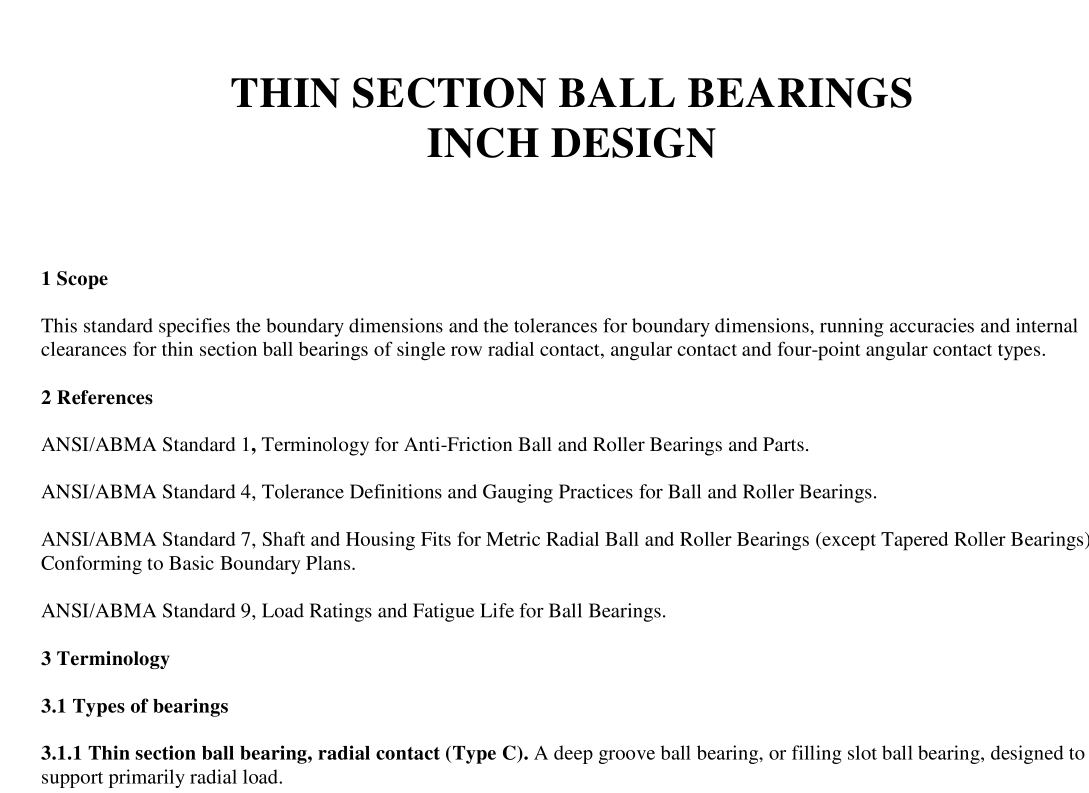ABMA 26.2:1994(S2013) pdf download.Thin Section Ball Bearings Inch Design ANSI/ABMA 26.2:1994
1 Scope
This standard specifies the boundary dimensions and the tolerances for boundary dimensions, running accuracies and internal clearances for thin section ball bearings of single row radial contact, angular contact and four-point angular contact types.
2 References
ANSI/ABMA Standard 1, Terminology for Anti-Friction Ball and Roller Bearings and Parts. ANSI/ABMA Standard 4, Tolerance Definitions and Gauging Practices for Ball and Roller Bearings. ANSI/ABMA Standard 7, Shaft and Housing Fits for Metric Radial Ball and Roller Bearings (except Tapered Roller Bearings) Conforming to Basic Boundary Plans. ANSI/ABMA Standard 9, Load Ratings and Fatigue Life for Ball Bearings.
3 Terminology
3.1 Types of bearings 3.1.1 Thin section ball bearing, radial contact (Type C). A deep groove ball bearing, or filling slot ball bearing, designed to support primarily radial load. 3.1.2 Thin section ball bearing, angular contact (Type A). A non-separable angular contact ball bearing with a counter-bored outer ring and a nominal 30° axial contact angle. 3.1.3 Thin section ball bearing, four-point contact (Type X). A four point contact ball bearing with a nominal 30° radial contact angle.
6 Boundary dimensions
The bearings covered in Table 1 include those in general use. The seven ball bearing Diameter Series (AA, A, B, C, D, F, and G) are unique in that the bearing cross-section in each series remains constant irrespective of the bore diameter. The three Width Series for each Diameter Series provide an extra width which may be necessary to accommodate an integral seal or shield on one or both sides of a bearing. These bearing designs are based on inch standards and a soft-conversion to metric units is provided in Annex A. The sizes shown in the table are selected to limit the number of bearing and component sizes, as much as possible, to promote economic production and yet provide a sufficient number of sizes and proportions to satisfy present and future needs of bearing users. These tables do not contain any indication as to availability of bearings.
7 Tolerances
7.1 General. The tolerance limits shown in Tables 2 through 9 are based on long established practice. They include tolerances for boundary dimensions and limits for runouts and normal radial internal clearance. See Clause 4 for tolerance definitions. The radial internal clearance limits are valid for bearings which are not mounted, and with zero measuring load. The unique proportions of these thin section bearings make some of the usual measuring and/or gauging practices impractical and unreliable. See Clause 8.7.2 Special internal clearance and preload. Certain applications may require a specific control of bearing operating or starting torque, or axial or radial load deflection. In such cases, the manufacturer should be consulted in order to determine, based on the application conditions and requirements, the optimal limits for radial internal clearance or preload for Type C or Type X bearings; or axial internal clearance or preload for Type A duplex mounting arrangements.
8 Inspection
Because of their very thin radial section, measurement of diameters, runouts and radial internal clearances is impractical or inaccurate using the recommended gauging practice described in ANSI/ABMA Standard 4. Even a very light gauge pressure in two-point diameter measurement may cause unacceptable radial deflection. Non-contacting gauging with the bearing axis preferably in a vertical position must be used for the measurement of inner ring bore diameters and outer ring outside diameters. Bearing rings may be out-of-round in the free state in excess of the ANSI/ABMA Standard 20 limits for the equivalent size; but this condition has proven to be acceptable since the rings readily conform to their shaft and housing seats. Diameter size for the thin section bearings is expressed in terms of an average which requires the averaging of diameter measurements taken at many angular positions, i.e., using the mean of a single minimum and a single maximum diameter is not sufficient. Tolerances for inner ring bore diameter and outer ring outside diameter do not apply to bearings supplied by the manufacturer with internal preload.
ABMA 26.2:1994(S2013) pdf download
